Obstacles Faced by Start-ups in Creating Circular Business Models
配送方式
-
台灣
- 國內宅配:本島、離島
-
到店取貨:
不限金額免運費




-
海外
- 國際快遞:全球
-
港澳店取:



內容簡介
the concept of circular economy has gained significant traction as a sustainable alternative to the traditional linear economic model. Circular business models emphasize the reduction of waste and the continual use of resources, promoting both environmental and economic benefits. While established companies are increasingly adopting circular practices, start-ups aiming to create circular business models encounter a unique set of challenges that demand innovative solutions.
One of the primary obstacles facing start-ups in this endeavour is the inherent complexity of transitioning to a circular model. Unlike linear models where resources are extracted, used, and discarded, circular models require intricate systems to manage product life cycles. Start-ups often lack the resources and expertise to design, implement, and monitor these complex systems effectively. Furthermore, building partnerships with suppliers, manufacturers, and waste management facilities can be challenging, especially when the concept of circularity is still relatively new and uncharted.
Securing sufficient funding presents another significant hurdle for start-ups pursuing circular business models. While the long-term benefits of circularity are substantial, the initial costs of redesigning production processes, establishing take-back mechanisms, and implementing recycling technologies can be daunting. Investors, often accustomed to traditional business models, might be hesitant to support ventures with unproven circular strategies. Start-ups must effectively communicate the potential return on investment and the broader positive impact on the environment to attract the necessary funding.
The regulatory landscape also poses challenges for start-ups venturing into circular economy initiatives. Existing regulations may not be tailored to accommodate innovative circular practices, creating uncertainty and potential legal barriers. Navigating complex waste management regulations and obtaining necessary permits can slow down a start-up's progress and increase compliance costs. Overcoming these hurdles requires proactive engagement with regulatory bodies to drive policy changes that enable and incentivize circular business approaches.
Consumer behaviour and market readiness form additional obstacles for start-ups aiming to implement circular models. Educating consumers about the value of circular products and changing their buying habits is an intricate process. Start-ups must convince customers to prioritize longevity, reparability, and recyclability over the allure of constant consumption and disposability. This demands effective marketing strategies, transparent communication, and the creation of a community around sustainable practices.
In conclusion, while circular business models hold immense promise for a sustainable future, start-ups face multifaceted challenges in their pursuit of such models. Overcoming the complexities of transitioning to circularity, securing funding, navigating regulatory landscapes, and shifting consumer behaviour necessitates a holistic and innovative approach. Collaborations between start-ups, established companies, government bodies, and investors are crucial to collectively address these challenges and pave the way for a more circular economy. As the understanding of circularity grows and stakeholders recognize its value, the landscape may become more favourable, facilitating the transformation of obstacles into opportunities for budding circular start-ups.
訂購/退換貨須知
加入金石堂 LINE 官方帳號『完成綁定』,隨時掌握出貨動態:
商品運送說明:
- 本公司所提供的產品配送區域範圍目前僅限台灣本島。注意!收件地址請勿為郵政信箱。
- 商品將由廠商透過貨運或是郵局寄送。消費者訂購之商品若無法送達,經電話或 E-mail無法聯繫逾三天者,本公司將取消該筆訂單,並且全額退款。
- 當廠商出貨後,您會收到E-mail出貨通知,您也可透過【訂單查詢】確認出貨情況。
- 產品顏色可能會因網頁呈現與拍攝關係產生色差,圖片僅供參考,商品依實際供貨樣式為準。
- 如果是大型商品(如:傢俱、床墊、家電、運動器材等)及需安裝商品,請依商品頁面說明為主。訂單完成收款確認後,出貨廠商將會和您聯繫確認相關配送等細節。
- 偏遠地區、樓層費及其它加價費用,皆由廠商於約定配送時一併告知,廠商將保留出貨與否的權利。
提醒您!!
金石堂及銀行均不會請您操作ATM! 如接獲電話要求您前往ATM提款機,請不要聽從指示,以免受騙上當!
退換貨須知:
**提醒您,鑑賞期不等於試用期,退回商品須為全新狀態**
-
依據「消費者保護法」第19條及行政院消費者保護處公告之「通訊交易解除權合理例外情事適用準則」,以下商品購買後,除商品本身有瑕疵外,將不提供7天的猶豫期:
- 易於腐敗、保存期限較短或解約時即將逾期。(如:生鮮食品)
- 依消費者要求所為之客製化給付。(客製化商品)
- 報紙、期刊或雜誌。(含MOOK、外文雜誌)
- 經消費者拆封之影音商品或電腦軟體。
- 非以有形媒介提供之數位內容或一經提供即為完成之線上服務,經消費者事先同意始提供。(如:電子書、電子雜誌、下載版軟體、虛擬商品…等)
- 已拆封之個人衛生用品。(如:內衣褲、刮鬍刀、除毛刀…等)
- 若非上列種類商品,均享有到貨7天的猶豫期(含例假日)。
- 辦理退換貨時,商品(組合商品恕無法接受單獨退貨)必須是您收到商品時的原始狀態(包含商品本體、配件、贈品、保證書、所有附隨資料文件及原廠內外包裝…等),請勿直接使用原廠包裝寄送,或於原廠包裝上黏貼紙張或書寫文字。
- 退回商品若無法回復原狀,將請您負擔回復原狀所需費用,嚴重時將影響您的退貨權益。








商品評價